The Society of Garden Designers' Journal, appropriately called The Garden Design Journal, published my short series of articles with the theme of City Spaces in 1998/1999. There would have been more but my career move got in the way!
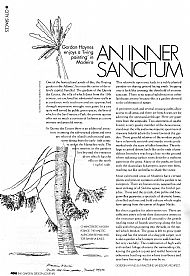
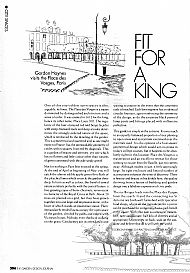
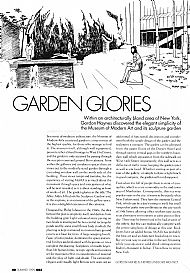
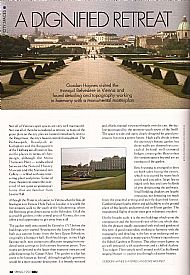
An Inner Sanctum
One of the horticultural jewels of Madeira, the 'floating garden in the Atlantic', lies near the centre of the island's capital, Funchal. The gardens of the Quinta das Cruzes, the villa of which dates from the 15th century, are enclosed by substantial stone walls in accordance with tradition and are approached through impressive wrought iron gates. In a city quite well served by public green spaces, the best of which is the Sao Francisco Park, the private quintas offer not so much a contrast of lushness as a more intimate and peaceful retreat.
At Qunita das Cruzes there is an additional attraction: in amongst the sub tropical plants and trees are relics of the island's architectural past, some dating from the early 16th century and in the Manueline style. The main interest in the gardens lies beyond the entrance drive which has the villa on the north side. This relatively open area leads to a richly planted paradise on sloping ground facing south. Stepping into it feels like crossing the threshold of an inner sanctum. There is no spatial subdivision or other landscape artistry because this is a garden devoted to the celebration of nature.
A perimeter path and several crossing paths allow access to all areas and there are bench seats set for admiring the spectacular foliage. Here are giant trees from the antipodes. Two specimens of Agathis brownii, a very gawky member of the Araucariaceae, stand near the villa and some majestic specimens of Araucaria bidwillii adorn the lower lawns of the garden. These graceful relatives of the monkey puzzle have relatively smooth and sturdy trunks pock-marked with the scars of fallen branches. Their foliage is carried almost larch-like at the ends of pendulous branches reaching close to the ground where radiating surface roots describe a starburst pattern in the grass. Many of the paths are lined with the Australian Sphaeropteris cooperi tree ferns, reaching out like umbrellas to shade the visitor.
Most cultivated areas of Madeira have certain plants and trees in common and this garden is no exception. There are banana trees, Agapanthus and, most striking of all, Strelitzia reginae, the bird of paradise. These and the cycads, date palms and Bougainvillea guarantee a spectacle of dramatic forms, chiselled outlines and bold colours which might have sprung from the canvas of August Macke.
But this is a garden for other senses too. There are sufficient pines to lend their distinctive aroma to the entrance area and all around is the gentle rustling noise of lizards scurrying along the low walls and of frogs popping into the tank, or the runnel which feeds it. The grass is left to grow quite long and has the texture of a shag pile carpet, so it is also a garden which tempts you to walk barefoot, but very carefully. The combination of high walls and verdant foliage obscures the surrounding city, leaving the garden a quiet and restful haven in an otherwise bustling sector where tour buses and taxis have free reign. May it ever be so.
_______________________________________________________________________________________
More recently, The Hull and District Branch of the World Ship Society have published some pieces from me in their quarterly journal The Humber Light. These extracts are from Autumn 2012:
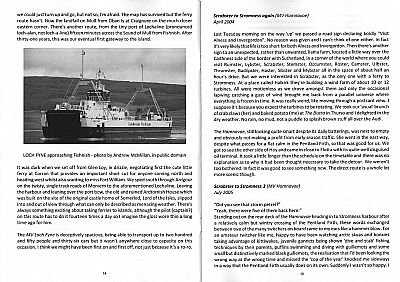
Great true adventures in gales and storms
being edited diary extracts involving ferry crossings to the Scottish islands
Scrabster to Stromness (MV Hamnavoe) April 2004
Last Tuesday morning on the way 'up' we passed a road sign declaring boldly "Visit Alness and Invergordon". No reason was given and I can't think of one either. In fact it's very likely that life is too short for both Alness and Invergordon. Then there's another sign to an unexpected, rather than unwanted, llama farm, located a little way over the Caithness side of the border with Sutherland, in a corner of the world where you could visit Rumster, Lybster, Scrabster, Stemster, Occumster, Roster, Camster, Ulbster, Thrumster, Badilpster, Haster, Sibster and Mybster all in the space of about half an hour's drive. But we were interested in Scrabster, as the only one with a ferry to Stromness. At a place called Halkirk they're building a wind farm of about 10 or 12 turbines. All were motionless as we drove amongst them and only the occasional lapwing catching a gust of wind brought me back from a parallel universe where everything is frozen in time. It was really weird, like moving through a postcard view. I suppose it's because you expect the turbines to be rotating. We took our 'usual' brunch of crab claws (her) and baked potato (me) at The Bistro in Thurso and I delighted in the dry weather. No rain, no mud, not a puddle to splash brown stuff all over the Audi.
The Hamnavoe, still looking quite smart despite its daily batterings, was next to empty and obviously not making a profit from early season traffic. She went in the east way, despite what passes for a flat calm in the Pentland Firth, so that was good for us. We got to see the other side of Hoy and came in close to Flotta with its quite well disguised oil terminal. It took a little longer than the schedule on the timetable and there was no explanation as to why it had been thought necessary to take the detour. We weren’t too bothered. In fact it was good to see something new. The direct route is a whole lot more scenic though.
Scrabster to Stromness again (MV Hamnavoe) July 2005
“Did you see that storm petrel?”
“Yeah, there were five of them back here.”
Standing out on the rear deck of the Hamnavoe heading in to Scrabster harbour after a relatively calm but wintry crossing of the Pentland Firth, these words exchanged between two of the many twitchers on board came to my ears like a hammer blow. For an amateur twitcher like me, happy to have been watching arctic skuas and bonxies taking advantage of kittiwakes, juvenile gannets being shown ‘dive and stab’ fishing techniques by their parents, puffins swimming and diving with guillemots and some small but distinctively marked black guillemots, the realisation that I’d been looking the wrong way at the wrong time and missed the ‘cop of the year’ knocked me sideways in a way that the Pentland Firth usually does on its own. Suddenly I wasn’t so happy. I was simultaneously dipped-out and gripped-off. I’ve been looking at birds quite a lot recently and rarely go walking without my 16 x 50s for company. So, for our third trip to see our daughter in Orkney, I probably concentrated more on twitching than I should have done. After all, there is still outstanding work on her house (it’s how I pay my way) and we still haven’t been out to any of the islands unconnected by Churchill Barriers. So, I missed the storm petrels, but on a positive note the short break away did bring several new sightings, including the aforementioned black guillemots. On Mull Head, which Kate and I walked to, we saw razorbills as well as the usual suspects: fulmars, guillemots, hooded crows, lapwings and oystercatchers. Later that evening I ate a guinea fowl, but that doesn’t count.
Uig to Tarbert (MV Hebrides) July 2009
When we go on holiday or take short breaks we tend not to repeat ourselves. We rarely do ‘Let's go back’. So it must have something to do with the exploration instinct winning out over the comfort zone that led us back to the Long Isle. There have been times of course, notably in recent years when we took several trips to Orkney for family reasons, but generally our taste takes us to new and interesting places - interesting because they’re new. What about France then? Well, our first breath of French air was in ’76 and we’ve been going back irregularly since then, but not to the same places or by the same sea crossings. The spiderweb of our routes through France, as traced onto Michelin maps, criss-crosses without thickening up much.
This month we made an exception to our normal plan and went back to Harris and Lewis, a journey taken only once before in 1973, when hair was a lot longer. On that occasion we were defeated by the weather and our intended fortnight of camping was reduced to three nights under canvas and one in a severely inadequate Stornoway hotel, a consequence of having missed the ferry back to Ullapool.
I wanted to see how I’d changed rather than how Harris and Lewis had, given that the pace of life there is slow, dead slow or stop and that most of my adult life had passed by. Would my reactions and emotions be comparable with those of thirty six years ago? I had no idea but I did know that I had loved the Harris landscape and desperately wanted not to be disappointed this time. I discovered that I have changed but Harris hasn’t. Not much anyway.
It took a day of my time fixing up the accommodation and the ferry. I got what might have been the last three rooms anywhere on the island for those three days, in three separate establishments, and had to settle for a ridiculously early 5.30 a.m. sailing from Uig, to boot. To Tarbert actually. If Scotland has been struggling with a downturn in the tourism sector they haven’t heard about it out west. Our itinerary was therefore more or less determined for us by where we could stay the night, of necessity moving on each day to the next empty room because long-gone are our carefree camping days. Actually, the camp sites looked pretty full too. Whoever we talked to was keen to let us know that it had been hot, sunny and rain-free for a month. ‘Yes, but watch it change now,’ I was thinking.
A 5.30 sailing means a 5.00 check-in, at the latest. We live about two hours from Uig, so go on, have a guess at when we had to get up. I don’t mean wake up, because that implies sleep and the impending wee-small-hours drive was just far too exciting to allow any of that to happen. We negotiated Scotch mist, swerved around countless death-wish deer in the half light and pulled into the terminal with an hour to spare. About thirty cars had got there before us, their steamed up windows suggesting an overnight stay in cramped conditions. Was it the lack of bedspaces or a reluctance to spend any more than absolutely necessary? Two big festivals were happening on Lewis, possibly the reason for everywhere being booked out, so it was just as well that I hadn’t accepted the alternative sailing at the equally awkward time for us of 2.00 p.m., which came with standby status. We were tired and looking forward to only another fifteen or sixteen hours of holiday-making that first day, but at least for the next bit somebody else was driving. Like the Pentland Firth, the Minch can be a wild and scary stretch of water but not so on this occasion. There was no pitching, yawing or rolling, only ninety minutes of gentle swell, each way. We were very lucky. There were some wonderful light effects too, most particularly as we entered East Loch Tarbert, when I found myself clicking away with gay abandon. There’s the first change: no worries about running out of film.
I had resurrected my old slides and wanted to retake some of them for a ‘then and now’ contrast, starting with Tarbert harbour. The ferry terminal is new but the fine whitewashed and crow-stepped house next to the pier still has its Monkey Puzzle tree and, here’s the remarkable thing, the tree is still the same size and shape. How can that be? I expected a few changes, not least with living organisms. There are new houses dotted around, mostly close to the shore. They look the same as all the old new ones, being in the Highland vernacular of characterless, timber-framed, roughcast bungalows. Architecture is virtually absent in Harris, the quality of its building stock reflecting the difficulty the population have always had in making a good living there. But you go for the beaches not the buildings, for the mountains not the museums. You come back, as you go, on the good ship Hebrides and then drive through Skye hoping to be rewarded with a dramatic storm over the Black Cuillins, and not without a reasonable chance of success.
______________________________________________________________________________________
The Humber Light published this Postcard from Cromarty in Spring 2014
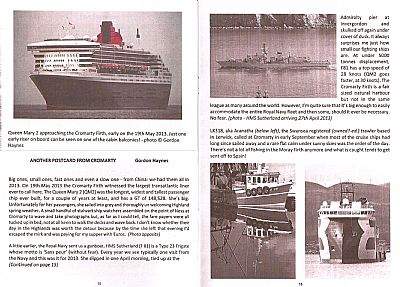
Big ones, small ones, fast ones and even a slow one - from China: we had them all in 2013. On 19th May 2013 the Cromarty Firth witnessed the largest transatlantic liner ever to call here. The Queen Mary 2 (QM2) was the longest, widest and tallest passenger ship ever built, for a couple of years at least, and has a GT of 148,528. She’s big. Unfortunately for her passengers, she sailed into grey and thoroughly unwelcoming Highland spring weather. A small handful of stalwart ship watchers assembled on the point of Ness at Cromarty to wave and take photographs but, as far as I could tell, the fare payers were all tucked up in bed, not at all keen to walk the decks and wave back. I don’t know whether their day in the Highlands was worth the detour because by the time she left that evening I was paying for my supper with Euros.
A little earlier, the Royal Navy sent us a gunboat. HMS Sutherland (F 81) is a Type 23 Frigate whose motto is ‘Sans peur’ (without fear). Every year we see typically one visit from the Navy and this was it for 2013. She slipped in one April morning, tied up at the Admiralty pier at Invergordon and skulked off again under cover of dusk. It always surprises me just how small our fighting ships are. At under 5000 tonnes displacement, F81 has a top speed of 28 knots (QM2 goes faster, at 30 knots). The Cromarty Firth is a fair sized natural harbour but not in the same league as many around the world. However, I’m quite sure that it’s big enough to easily accommodate the entire fleet and then some, should it ever be necessary. No fear.
LK318, aka Aranatha, the Swansea registered trawler based in Lerwick, called at Cromarty in early September when most of the cruise ships had long since sailed away and a rare flat calm under sunny skies was the order of the day. There’s not a lot of fishing in the Moray Firth any more and what is caught tends to get sent off to Spain!
From Norway came the Bourbon Orca, a fairly regular visitor and often seen at Aberdeen. She was here this time to pull the semi-sub drilling rig Wil Phoenix back out to the North Sea on 1st May. The Ulstein X-Bow is the distinguishing feature of this AHTS. A few years back, with the Transocean Rather in tow, she made her slow way south from here, past the Humber and through the Channel, aiming her Roman nose out into the Atlantic and down to Angola, but I see that the rig is now parked in Brunei Bay.
When the jack-up rigs are brought in for maintenance they usually get tugged in, their legs fully extended above the decks, which then act as a hull. Occasionally, for long hauls, they are brought in by a Heavy Lift Vessel, like the Talisman, seen here with the rig Prospector 1 amidships. Ballast tanks are then flooded to allow the rig to float off, leaving the HLV looking distinctly distressed. This was the highlight of November’s movements in the firth. Prospector 1 was made in China, like so many of our imports these days, and her maiden assignment was to act as Cromarty’s community Christmas tree.
_________________________________________________________________________________________
Historic Gardens Review published my article on three Scottish Castle Gardens under their feature Flying Visits in December 2014 (HGR 31).
Humber Light published an article from me in their final issue (Vol.53, No.4: Autumn 2015).
_________________________________________________________________________________________
Other titles where my work has been published include:-
Landscape Design
Landscape Scotland Quarterly
The Royal Caledonian Horticultural Society Journal
Faculty of Building Journal
The Scottish Garden
Shipshape (Journal of the Yorkshire Shipping Enthusiasts)
Decanter

